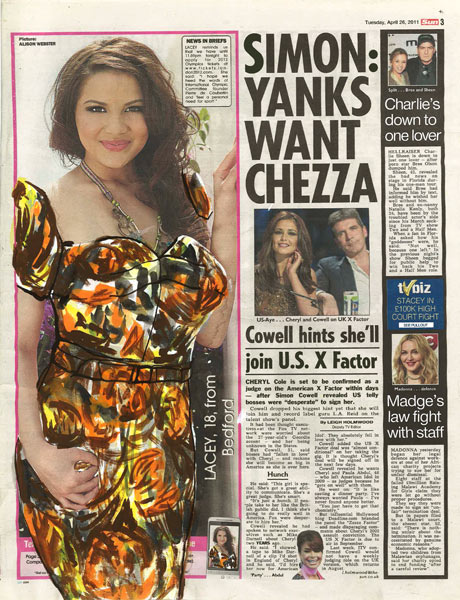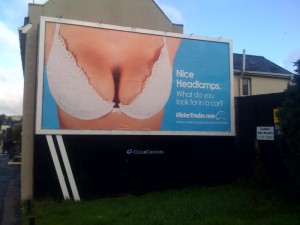 |
| Is it a simple case of covering up? Or are the issues much deeper? (Pic : The Guardian) |
Around a fortnight ago, the Assembly unanimously agreed - following a cross-party debate - that The Sun's Page 3 feature should be discontinued.
Time's set aside every few weeks for debates on whatever AMs want to discuss. I wouldn't be surprised if AMs have since been criticised for not discussing something "more important", but I think it's a good thing they debate issues like this – issues that aren't top of the political agenda, but topical.
It reads as though the debate itself was good-humoured and raised many interesting points.
I thought Page 3, or its equivalent, was a "British thing", but it looks though as if it has various manifestations globally. The Sun aren't the only ones who do it in the UK either – The Daily Star do so too, while there's also Mail Online's efforts.
A grass-roots campaign against Page 3 is starting to bear fruit, with high-profile activism and even a concession from Rupert Murdoch that Page 3 could be dropped in favour of "clothed fashionistas" in the future. I don't know what that means exactly, but it could easily mean something worse. Some clothes leave very little to the imagination.
First thing's first, the Assembly or Welsh Government can't do anything about it. I don't think even the UK Government would try. It'll have to be done voluntarily or indirectly, with co-operation from newspapers – and I think that's the right way to approach it.
Why should Page 3 go?
Any objections I have to Page 3 come from a different direction – there's not enough "non-sexualised" nudity out there, so we all end up with hang-ups about what things should or shouldn't look like.
| Hypocrisy now (Pic : themediablog.co.uk) |
Page 3 is a bit childish. It reinforces prudish and unhealthy attitudes about sex because on the one hand you have populist ranting against pornography, and on the other hand, bare breasts are presented as bawdy to the point of being comical. That's not healthy.
I suppose its original aim was to be "edgy" and a "poke in the eye of political correctness", but it isn't anymore. It's a bit....sad. It's a bit Benny Hill and flared trousers.
Then there's the impact on body image. If I turned the first page of your average tabloid, only to be confronted with ten inches of diamond-cutting King Dong and an eight pack, I'd probably feel uncomfortable.
I imagine there would be a similar effect for some women when confronted with topless photos alongside their "news".
Most women don't look like Page 3 models, and the pool from which they're drawn from probably numbers 0.1% of the adult population. The same thing goes for male models too. It's a myth that there's one be all and end all of what constitutes "attractive", as we're all going to have different ideas on that.
So Page 3 is wrong because it's too generic. If we're going to have nudity, it should be of all colours, shapes and sizes, shouldn't it?
 |
| Bernadette, 22, from Purfleet. Anal Trauma. (digplanet.com) |
Take Channel 4's "Embarrassing Bodies". You can see - not only plenty of body parts of all kinds - but complete rectal prolapses, skin lesions oozing pus and STIs destroying genitalia one sore at a time.
I think it's a triumph.
You also have to consider the more practical consequences arising from this that we might not think about.
What effect does it have on women who want to breast feed in public? Women who might want to bathe topless for comfort? Would women be worried about going for a mammogram or exercising because they've had seeds planted in their heads that they should measure up a certain way?
For example, 139 people with nothing better to do with their lives complained about Holly Willoughby's choice of clothing a few weeks ago.
This, in part, results from the attitude Page 3 perpetuates – body parts are only allowed to be seen when it's got something to do with sex or sex selling stuff. It could directly impact what women feel they can or can't wear/do to avoid being labelled or stereotyped. That's the real problem as I see it, not the breasts themselves.
Until we eliminate that attitude, we're unable to have grown up discussions about "things that really matter" - like sex education, sexuality, pornography and teenage pregnancies/sexual activity.
If we're going to have debates on those issues, we have to be able to do so without resorting to outdated and hypocritical Victorian rhetoric about modesty, or only presenting idealised and uncommon human forms.
Models? Or Objects?
 |
| Are there varying degrees of objectification? Is the above example worse than Page 3? (Pic : adrants.com) |
I doubt Page 3 qualifies as objectification under the strictest definitions. If Page 3 were just a photo of a pair of breasts every day, then it would qualify because you're quite literally reducing someone to a sum part, like a cut of meat. I'd say Page 3 is a soft form of objectification - casual, expected, and missed when not there.
However, Page 3 models have names – albeit single pet names. They're also clearly doing it willingly, even if they're two dimensional and any quotes attributed to them are done so sarcastically.
You can argue the models are making a free choice to pursue a career, and the decision to do it rests with them alone. I agree with that. I doubt it's a question of whether the models are being objectified, but whether their material belongs in newspapers instead of magazines.
I know this is going to come as a terrible shock to you all, but straight men objectify women we find attractive (to varying degrees). I'm not going to claim that I'm some sort of enlightened man, because that would be a condescending lie - I'm willing to admit I do it as well. I'm also willing to bet you do too regardless of gender or sexuality.
I'm not talking about cat-calls, groping and unwelcome advances - that's wrong. I'm talking about the stuff in your head. It's often said men think about sex "every seven seconds", but to put things in perspective, the reality's more like for seven seconds every hour.
This sounds silly, but we do it without thinking about it and shouldn't need a newspaper to do it for us. It's a type of day-dreaming, and if that's what activists are trying to fight as "objectification" then I don't think they're picking the right battles.
I'd say the majority are able to do that privately and don't expect women to take whatever fantasy we might have as "a compliment". You can easily switch it on and off, making sure it's appropriate to the situation. Most of us know it's not polite to leer and - hiding behind bluster in front of friends - will be genuinely embarrassed if we get caught out.
It's those men (and women) who don't have an off switch who are the problem, combined with peer-pressure, things like alcohol and "expecting something" from it. That's probably because they lack willpower to do it in their head, confusing fantasy with reality and crossing boundaries that shouldn't be crossed.
I doubt you can really do anything about "mental objectification" because it's a key part of attraction, flirting and all that stuff. You might be able to "unlearn" it, I don't know.
You can do something about the commodified "hard" versions that give people the impression that it's OK to do it openly through blurring the boundaries between fantasy and reality – like Page 3.














